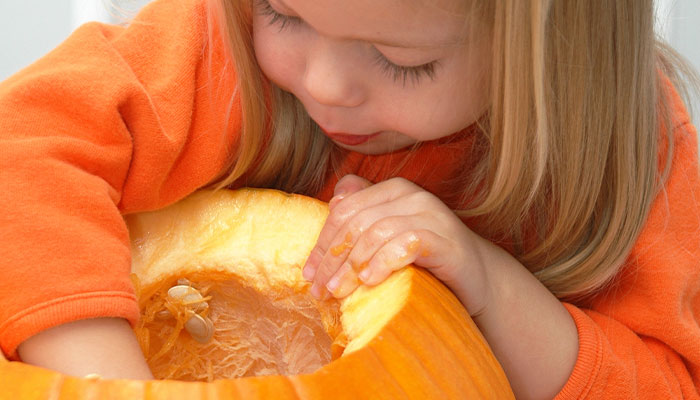While we believe that the books and resources recommended may be of value to you, keep in mind that these are suggestions only and you must do your own due diligence to determine whether the materials are appropriate and suitable for your use. PNC has no sponsorship or endorsement agreement with the authors or publishers of the materials listed.
FALL

Pumpkin Pudding
Children will learn about the pumpkin, including that it’s edible.

Lesson Objective
Children will explore the parts of a pumpkin and understand that pumpkins are edible.
Science
What You'll Need
- 1 pie pumpkin (these are a smaller and sweeter variety of pumpkins) per 10 children
- Vanilla yogurt (½ cup per child)
- Sharp knife (to cut the pumpkin)
- Microwave oven
- Blender
- Colander
- Measuring cups – ½ cup – 1 per 4 children
- Measuring spoons – 1 tablespoon – 1 per 4 children
- Large, microwavable casserole dish with a lid
- Sturdy plastic spoons – 2 per child
- Paper or plastic bowls – 3 per child
What To Do
Note: Do this lesson after you do the lesson, The Pumpkin and Its Parts, available on this website.
This recipe has a number of steps, but it is a wonderful way for children to see the original source of pumpkin puree (not from a can!).
- Invite the children to help you gently rinse the outside of the pumpkin in warm water and dry it off.
- Cut the pumpkin in half, and trim off the stem. Continue to cut in half until there are 8 sections. Cut the individual sections in half crosswise to make 16 pieces.
- Give each child a section of the pumpkin, a bowl, and a plastic spoon.
- Show them how to remove all of the seeds and stringy parts by scraping the inside of the pumpkin piece and putting them into the bowl.
- Place the scraped pumpkin pieces into the microwaveable dish, add a couple of inches of water, and place the lid on the dish.
- Cook for 15 minutes on high (do not leave unattended), then check to see if the pumpkin is tender.
- Cook the pumpkin pieces for another 5 minutes, then check them again. Repeat the process until the pumpkin is easily mashed with a fork.
- Let the pieces cool and give one to each child with a spoon and a bowl. Show the children how to use the spoon to gently lift and scoop the cooked pumpkin out of the skin and place it into their bowl. Throw the skin in the trash. Let the children use their spoons to mash the cooked pumpkin.
- Combine all of the pumpkin mash, and place it in the colander. Let any extra moisture drain out.
- Pour the pumpkin mash into the blender, and puree it.
- Have each child measure ½ cup of the yogurt and pour it into a clean bowl.
- Then, let each child measure out 1 tablespoon of the pumpkin puree and add it to the yogurt in their bowl.
- Give each child a clean spoon to mix the ingredients together and eat!
Resources
Home School Resources
Home educators: use these printable lesson PDFs to teach this lesson to your home schoolers. They're available in English and Spanish.
Content Provided By
Common Core State Standards Initiative – These lessons are aligned with the Common Core State Standards ("CCSS"). The CCSS provide a consistent, clear understanding of the concepts and skills children are expected to learn and guide teachers to provide their students with opportunities to gain these important skills and foundational knowledge [1]. Visit the CCSS


